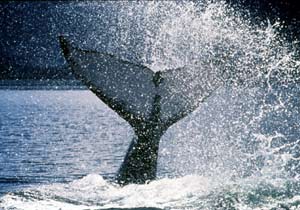One of the ironies of the fight to end commercial whaling is that over the past decade whale watching has shown the potential to become far more profitable than whaling ever was. It is already generating a staggering $1.25 billion per year globally.
Whale watching takes advantage of the fact that most whales are migratory, moving around the oceans at different times of the year to breed and feed. Much of this migration takes place in coastal waters, where large whale pods can often be clearly seen, either from small boats or from the shore.
 The advantages of this kind of eco-tourism are many; if conducted properly it is benign; it can be very profitable; it provides a resource for genuine cetacean research; and it promotes an appreciation of the marine environment and conservation issues among a wider public.
The advantages of this kind of eco-tourism are many; if conducted properly it is benign; it can be very profitable; it provides a resource for genuine cetacean research; and it promotes an appreciation of the marine environment and conservation issues among a wider public.
World-wide, an estimated nine million people go whale watching every year in 87 countries. This number has increased on average by 12 percent annually since 1991, and looks set to rise. 34 of the 40 member countries (85 percent) of the International Whaling Commission (IWC) now have a domestic whale watching industry. The most explosive growth has been in Iceland, which has experienced 500 percent growth over the past decade, making the industry far more valuable to the Icelandic economy than commercial whaling ever was.
Even the figures for Norway and Japan, the two countries who most support commercial whaling, show a growth rate far above the average. Whale watching in Norway has grown 18 percent per year since 1994, earning an annual revenue of $12 million, while in 1998 102,785 people went whale and dolphin watching in Japan, spending an estimated US$33 million.
Under it's charter, the IWC must ensure the optimum utilisation of whale stocks - more and more of the IWC's member nations have come to realise this can be best achieved through non-lethal forms of exploitation such as whale watching. Plans put forward by Australia and Brazil for sanctuaries in the South Pacific and Atlantic oceans at the 1998 conference acknowledge this reality - so far they have been defeated by Japan's "vote buying" strategy.
As the global whale-watching industry continues its rapid growth, it is becoming ever clearer that a benign use of cetacean resources is commercially as well as ecologically desirable. But there are potential pitfalls - whales face an increasing number of environmental threats from contaminants such as PCBs, and other forms of pollution. The IWC is uniquely placed to address these threats, and ensure long-term protection for all the world's whales.

